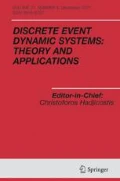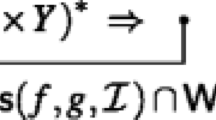Abstract
Many large-scale multi-agent missions consist of a sequence of subtasks, each of which can be accomplished separately by having agents execute appropriate decentralized controllers. However, many decentralized controllers have network topological prerequisites that must be satisfied in order to achieve the desired effect on a system. Therefore, one cannot always hope to accomplish the original mission by having agents naively switch through executing the controllers for each subtask. This paper extends the Graph Process Specification (GPS) framework, which was presented in previous work as a way to script decentralized control sequences for agents, while ensuring that network topological requirements are satisfied when each controller in the sequence is executed. Atoms, the fundamental building blocks in GPS, each explicitly state a network topological transition. Moreover, they specify the means to make that transition occur by providing a multi-agent controller, as well as a way to locally detect the transition. Scripting a control sequence in GPS therefore reduces to selecting a sequence of atoms from a library to satisfy network topological requirements, and specifying interrupt conditions for switching. As an example of how to construct an atom library, the optimal decentralization algorithm is used to generate atoms for agents to track desired multi-agent motions with when the network topology is static. The paper concludes with a simulation of agents performing a drumline-inspired dance using decentralized controllers generated by optimal decentralization and scripted using GPS.







Similar content being viewed by others
References
Alamir M, Attia S (2004) On solving optimal control problems for switched hybrid nonlinear systems by strong variations algorithms. In: Proceedings of 6th IFAC symposium on nonlinear control systems, pp 558–563
Antsaklis P (2000) A brief introduction to the theory and applications of hybrid systems. In: Proc IEEE, special issue on hybrid systems: theory and applications, Citeseer
Attia S, Alamir M, de Wit C (2005) Sub optimal control of switched nonlinear systems under location and switching constraints. In: IFAC world congress
Axelsson H, Wardi Y, Egerstedt M, Verriest E (2008) Gradient descent approach to optimal mode scheduling in hybrid dynamical systems. J Optim Theory Appl 136(2):167–186
Bamieh B, Paganini F, Dahleh M (2002) Distributed control of spatially invariant systems. IEEE Trans Automat Contr 47(7):1091–1107
Bemporad A, Borrelli F, Morari M (2000) Piecewise linear optimal controllers for hybrid systems. In: Proceedings of the American Control Conference, 2000. IEEE, vol 2, pp 1190–1194
Branicky M, Borkar V, Mitter S (1998) A unified framework for hybrid control: model and optimal control theory. IEEE Trans Automat Contr 43(1):31–45
Brockett R (1988) On the computer control of movement. In: Proceedings of IEEE international conference on robotics and automation, vol 1, pp 534–540
Couzin I, Franks N (2003) Self-organized lane formation and optimized traffic flow in army ants. Proc R Soc Lond, B Biol Sci 270(1511):139
Egerstedt M, Wardi Y, Axelsson H (2006) Transition-time optimization for switched-mode dynamical systems. IEEE Trans Automat Contr 51(1):110–115
Eren T, Whiteley W, Anderson B, Morse A, Belhumeur P (2005) Information structures to secure control of rigid formations with leader-follower architecture. In: Proceedings of the American Control Conference, 2005. IEEE, pp 2966–2971
Hedlund S, Rantzer A (1999) Optimal control of hybrid systems. In: Proceedings of the 38th IEEE Conference on Decision and Control, 1999. IEEE, vol 4, pp 3972–3977
Jadbabaie A, Lin J, Morse A (2003) Coordination of groups of mobile autonomous agents using nearest neighbor rules. IEEE Trans Automat Contr 48(6):988–1001
Ji M, Egerstedt M (2007) Distributed coordination control of multiagent systems while preserving connectedness. IEEE Trans Robot 23(4):693–703
Johansson K, Egerstedt M, Lygeros J, Sastry S (1999) On the regularization of Zeno hybrid automata. Syst Control Lett 38(3):141–150
Kloetzer M, Belta C (2007) Temporal logic planning and control of robotic swarms by hierarchical abstractions. IEEE Trans Robot 23(2):320–330
Koutsoukos X, Antsaklis P, Stiver J, Lemmon M (2000) Supervisory control of hybrid systems. Proc IEEE 88(7):1026–1049
Lin Z, Broucke M, Francis B (2004) Local control strategies for groups of mobile autonomous agents. IEEE Trans Automat Contr 49(4):622–629
Liu Y, Passino K, Polycarpou M (2003) Stability analysis of one-dimensional asynchronous swarms. IEEE Trans Automat Contr 48(10):1848–1854
Lynch N (1996) Distributed algorithms. Morgan Kaufmann
Manikonda V, Krishnaprasad PS, Hendler J (1998) Languages, behaviors, hybrid architectures and motion control. In: Willems J, Baillieul J (eds) Mathematical control theory, Springer-Verlag
Martin P, de la Croix J, Egerstedt M (2008) MDLn: a motion description language for networked systems. In: Proceedings of 47th IEEE Conference on Decision and Control
McNew J, Klavins E (2006) Locally interacting hybrid systems with embedded graph grammars. In: Proceedings of the 45th IEEE Conference on Decision and Control, 2006. pp 6080–6087
Mesbahi M, Egerstedt M (2010) Graph theoretic methods for multiagent networks. Princeton University Press, Princeton, NJ
Morse A (1997) Control using logic-based switching. Citeseer
Motee N, Jadbabaie A (2008) Optimal control of spatially distributed systems. IEEE Trans Automat Contr 53(7):1616–1629
Muhammad A, Egerstedt M (2005) Connectivity graphs as models of local interactions. Appl Math Comput 168(1):243–269
Olfati-Saber R, Murray R (2004) Consensus problems in networks of agents with switching topology and time-delays. IEEE Trans Automat Contr 49(9):1520–1533
Olfati-Saber R, Fax J, Murray R (2007) Consensus and cooperation in networked multi-agent systems. Proc IEEE 95(1):215–233
Rantzer A (2007) A separation principle for distributed control. In: Proceedings of the 45th IEEE Conference on Decision and Control, 2006. IEEE, pp 3609–3613
Ren W, Beard R (2005) Consensus seeking in multiagent systems under dynamically changing interaction topologies. IEEE Trans Automat Contr 50(5):655–661
Rotkowitz M, Lall S (2006) A characterization of convex problems in decentralized control. IEEE Trans Automat Contr 51(2):274–286
Shaikh M, Caines P (2002) On trajectory optimization for hybrid systems: theory and algorithms for fixed schedules. In: Proceedings of the 37th IEEE Conference on Decision and Control, 1998. IEEE, vol 2, pp 1997–1998
Shaikh M, Caines P (2003) On the optimal control of hybrid systems: optimization of trajectories, switching times, and location schedules. In: Proceedings of the 6th international conference on Hybrid systems: computation and control, Springer-Verlag, pp 466–481
Shaikh M, Caines P (2007) On the hybrid optimal control problem: theory and algorithms. IEEE Trans Automatic Control 52(9):1587–1603
Smith B, Howard A, McNew J, Wang J, Egerstedt M (2009) Multi-robot deployment and coordination with embedded graph grammars. Auton Robots 26(1):79–98
Tanner H, Pappas G, Kumar V (2004) Leader-to-formation stability. IEEE Trans Robot Autom 20(3):443–455
Tanner H, Jadbabaie A, Pappas G (2007) Flocking in fixed and switching networks. IEEE Trans Automat Contr 52(5):863–868
Twu P, Egerstedt M (2010) Optimal decentralization of multi-agent motions. In: Proceedings of the American Control Conference, 2010. IEEE, pp 2326–2331
Twu P, Martin P, Egerstedt M (2010) Graph process specifications for hybrid networked systems. In: Proceedings of 10th international workshop on discrete event systems
Xiao L, Boyd S, Lall S (2006) A space-time diffusion scheme for peer-to-peer least-squares estimation. In: Proceedings of the 5th international conference on information processing in sensor networks, ACM, pp 168–176
Xu X, Antsaklis P (2002a) Optimal control of switched autonomous systems. In: Proceedings of the 41st IEEE Conference on Decision and Control, 2002. IEEE, vol 4, pp 4401–4406
Xu X, Antsaklis P (2002b) Optimal control of switched systems via non-linear optimization based on direct differentiations of value functions. Int J Control 75 16(17):1406–1426
Acknowledgements
This work was sponsored by the US National Science Foundation through Grant # CCF 0820004, and ONR through MURI HUNT. The authors would also like to thank Prof. Christopher Moore for discussions about the Georgia Tech drumline.
Author information
Authors and Affiliations
Corresponding author
Rights and permissions
About this article
Cite this article
Twu, P.Y., Martin, P. & Egerstedt, M.B. Graph process specifications for hybrid networked systems. Discrete Event Dyn Syst 22, 541–577 (2012). https://doi.org/10.1007/s10626-012-0134-2
Received:
Accepted:
Published:
Issue Date:
DOI: https://doi.org/10.1007/s10626-012-0134-2




